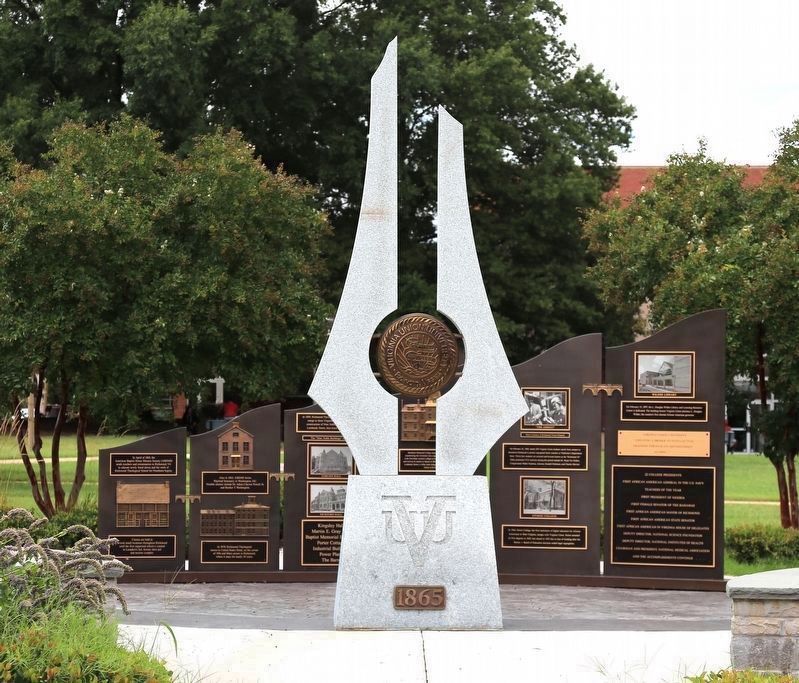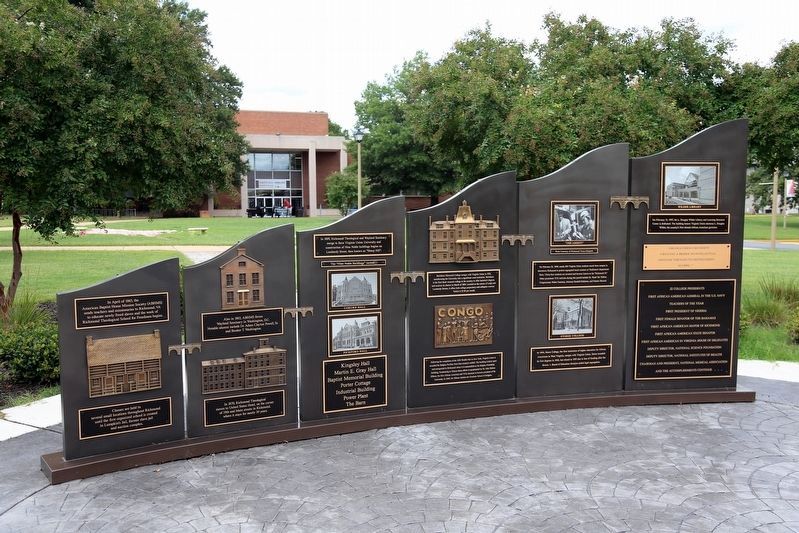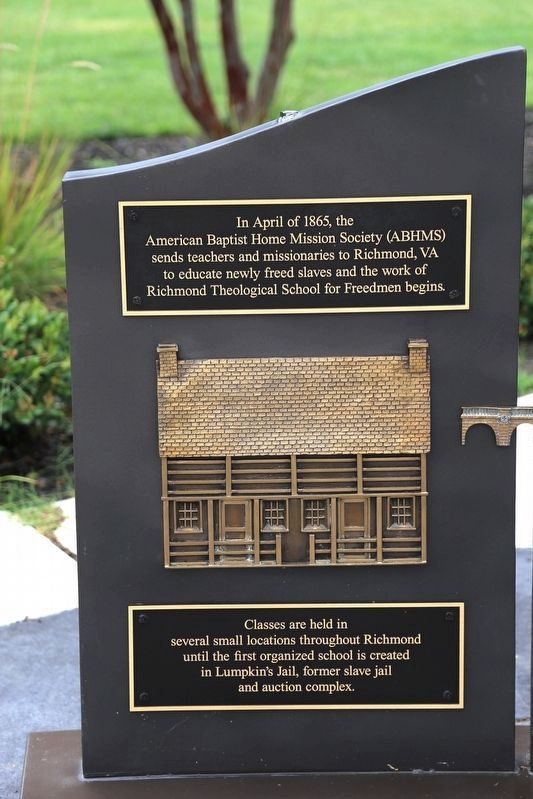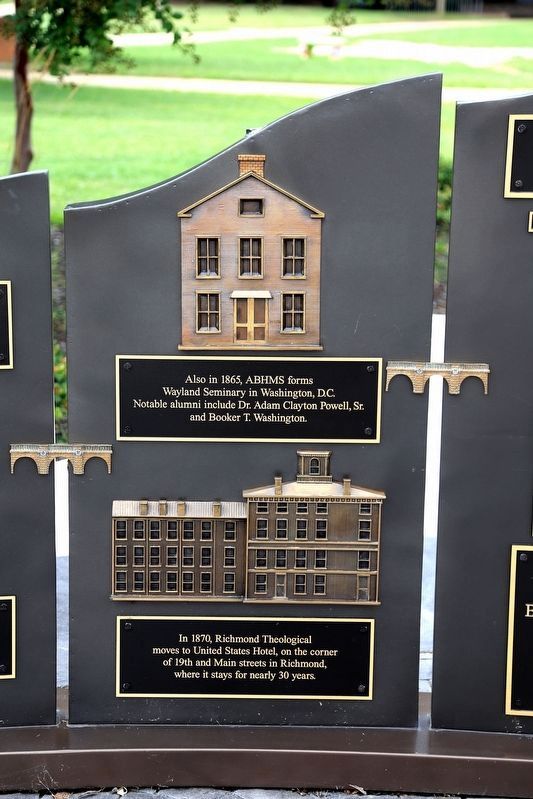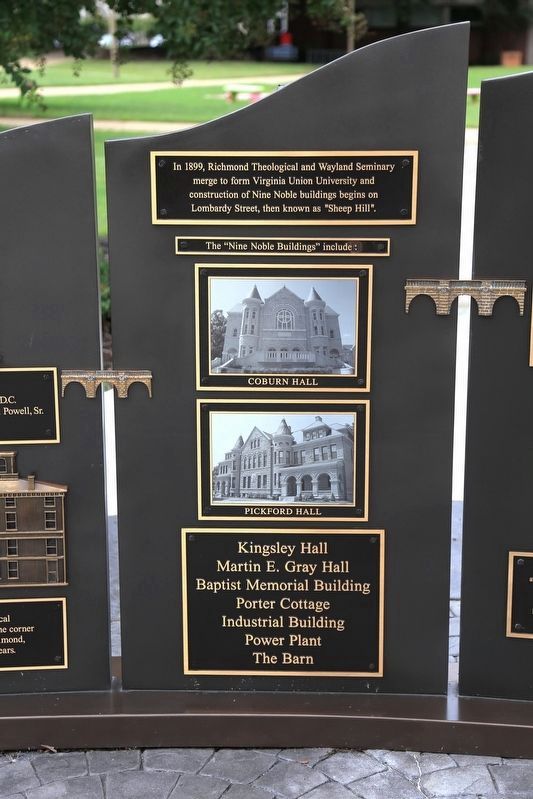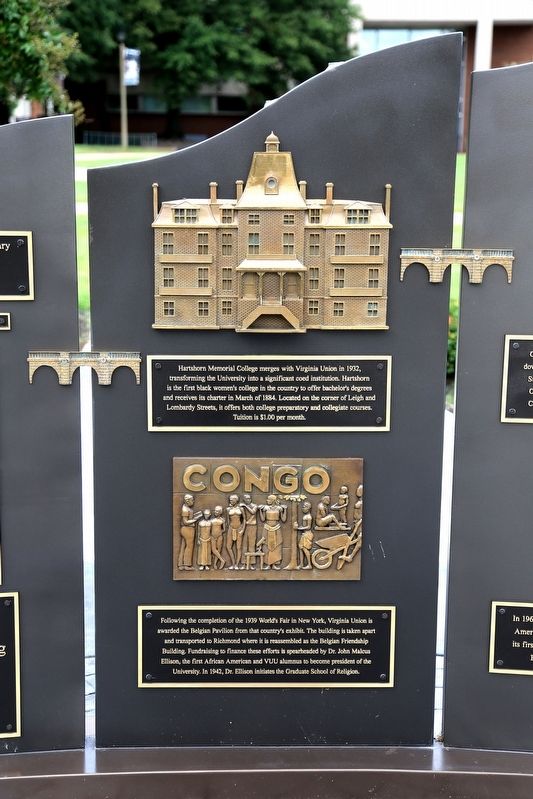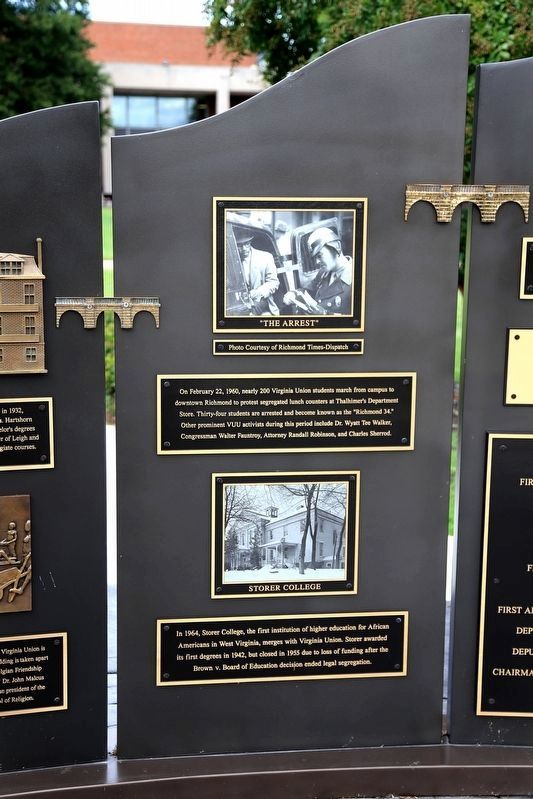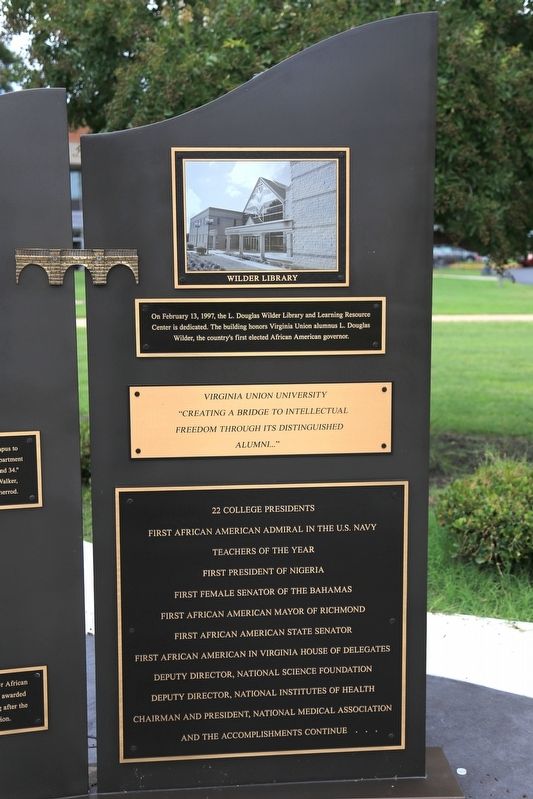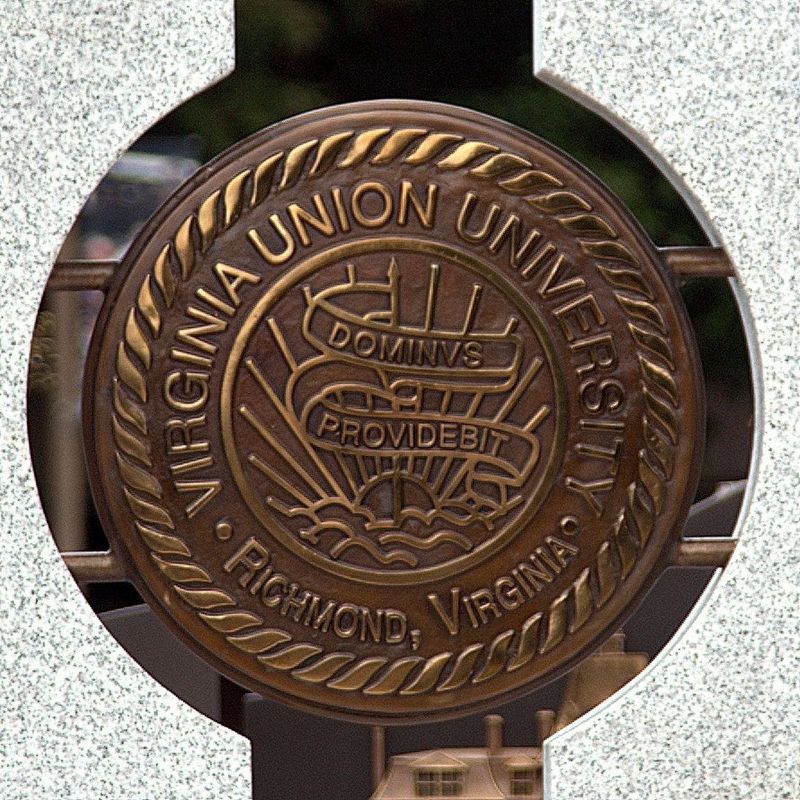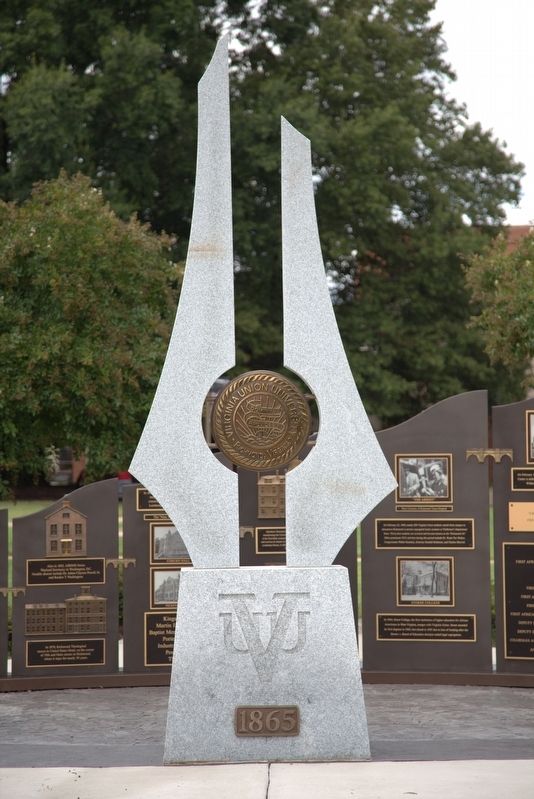Virginia Union in Richmond, Virginia — The American South (Mid-Atlantic)
Virginia Union University 150th Anniversary Memorial
“Creating a Bridge to Intellectual Freedom Through Its Distinguished Alumni”
— 1865 —
Inscription.
In Apri of 1865, the American Baptist Home Mission Society (ABHMS) sends teaches and missionaries to Richmond, VA to educate newly freed slaves and the work of Richmond Theological School for Freedmen begins.
Classes are held in several small locations throughout Richmond until the first organized school is created in Lumpkins Jail, a former slave jail and auction complex.
Also in 1865, ABHMS forms Wayland Seminary in Washington , D.C. Notable alumni include Dr. Adam Clayton Powell, Sr., and Booker T. Washington.
In 1870, Richmond Theological moves to United States Hotel, on the corner of 19th and Main streets in Richmond, where it stays for nearly 30 years.
In 1899, Richmond Theological and Wayland Seminary merge to form Virginia Union University and construction of Nine Noble buildings begins on Lombardy Street, then known as “Sheep Hill”. The “Nine Noble Buildings” include: Coburn Hall, Pickford Hall, Kingsley Hall, Martin E. Gray Hall, Baptist Memorial Building, Porter Cottage, Industrial Building, Power Plant, The Barn.
Hartshorn Memorial College merges with Virginia Union in 1932, transforming the University into a significant co-ed institution. Hartshorn is the first black women’s college in the country to offer bachelor’s degrees and receives its charter in March of 1884. Located on the corner of Leigh and Lombardy Streets, it offers both college preparatory and collegiate courses. Tuition is $1.00 per month.
Following completion of the 1939 World’s Fair in New York, Virginia Union is awarded the Belgian Pavilion from that country’s exhibit. The building is taken apart and transported to Richmond where it is reassembled as the Belgian Friendship Building. Fundraising to finance these efforts is spearheaded by Dr. John Malcus Ellison, the first African American and VUU alumnus to become president of the University. In 1942, Dr. Ellison initiates the Graduate School of Religion.
On February 22, 1960, nearly 200 Virginia Union students march from campus to downtown Richmond to protest segregated lunch counters at Thalhimer’s Department Store. Thirty-four students are arrested and become known as the “Richmond 34.” Other prominent VUU activists during this period include Dr. Wyatt Tee Walker, Congressman Walter Fauntroy, Attorney Randall Robinson, and Charles Sherrod.
In 1964, Storer College, the first institution of higher education for African Americans in West Virginia, merges with Virginia Union. Storer awarded its first degrees in 1942, but closed in 1955 due to loss of funding after the Brown v. Board of Education decision ended legal segregation.
On February 13, 1997, the L. Douglas Wilder Library and Learning Resource Center is dedicated. The building honors Virginia Union alumnus L. Douglas Wilder, the country's first elected African American governor.
Virginia Union University “Creating a bridge to intellectual freedom through its distinguished alumni…” 22 college presidents • First African American admiral in the U.S. Navy • Teachers of the Year • First president of Nigeria • First female senator of the Bahamas • First African American mayor of Richmond • First African American state senator • First African American in Virginia House of Delegates • Deputy director, National Science Foundation • Deputy Director, National Institutes of Health • Chairman and President, National Medical Association • and the accomplishments continue . . .
Erected 2015.
Topics and series. This historical marker and memorial is listed in these topic lists: African Americans • Arts, Letters, Music • Churches & Religion • Civil Rights • Education • Government & Politics • Notable Buildings • Women. In addition, it is included in the Historically Black Colleges and Universities series list. A significant historical year for this entry is 1865.
Location. 37° 33.709′ N, 77° 27.011′ W. Marker is in Richmond, Virginia. It is in Virginia Union. Marker can be reached from the intersection of North Lombardy Street and Brook Road, on the right when traveling south. Touch for map. Marker is at or near this postal address: 1500 N Lombardy St, Richmond VA 23220, United States of America. Touch for directions.
Other nearby markers. At least 8 other markers are within walking distance of this marker. Huntley Hall (within shouting distance of this marker); Henderson Center (within shouting distance of this marker); Ellison Hall (about 300 feet away, measured in a direct line); Coburn Hall (about 300 feet away); First Southern African American Girl Scouts (about 400 feet away); Virginia Union University (about 500 feet away); Pickford Hall (about 500 feet away); Martin E. Gray Hall (about 600 feet away). Touch for a list and map of all markers in Richmond.
More about this memorial. The six panels have the following illustrations. Click on each photo to zoom in to examine them. Bas-reliefs of Lumpkin’s Jail, Wayland Seminary, the United States Hotel, Hartshorn College and a reproduction of a part of the friezes from the former Belgian Pavilion now on campus; and photographs of Coburn Hall, Pickford Hall, “the Arrest”, Storer College, and the Wilder Library.
Also see . . .
1. University History. “However, on May 13, 1867, Dr. Nathaniel Colver an elderly, hard-bitten abolitionist who could not be intimidated by anyone, arrived to resume the task. He had a great deal of trouble even finding suitable accommodations to rent, and was close to despair when he had a chance meeting with Mrs. Mary Ann Lumpkin, from whom he was able to rent a patch of land and buildings at 15th & Franklin Streets known as Lumpkin’s Jail or “The Devil’s Half Acre”. ” (Submitted on October 15, 2017.)
2. God’s Half Acre. 2015 article by Harry Kollatz Jr. in Richmond Magazine. “‘Did Northern Baptists design to humiliate Southern Baptists, by using Lumpkin’s Slave Jail, at the opening of their Freedmen School-work in Richmond, Virginia? No, the farthest from it. I remember that it was so hinted, at the time. Some may still believe it. But I am glad to be able to show that the occupancy of those premises was wholly providential.’ —The Rev. James B. Simmons, in a letter published as part of an 1895 history of the school that became Virginia Union University.” (Submitted on October 15, 2017.)
3. Building Virginia Union. 2015 article by Harry Kollatz Jr. in Richmond Magazine. “The impressive sandstone friezes by Oscar Jespers, Henry Puvrez and Arthur Dupagne on the main building depict the Belgian Congo with robust enthusiasm and energy, but do not illustrate the genocidal brutality of the colonialist Belgians in Congo. As works of art, however, they are notable. And perhaps the Belgians’ behavior in the Congo influenced the choice to place them on the campus of a university serving African-Americans.” (Submitted on October 15, 2017.)
Credits. This page was last revised on February 1, 2023. It was originally submitted on October 15, 2017, by J. J. Prats of Powell, Ohio. This page has been viewed 493 times since then and 51 times this year. Photos: 1, 2, 3, 4, 5, 6, 7, 8, 9, 10. submitted on October 15, 2017, by J. J. Prats of Powell, Ohio.
